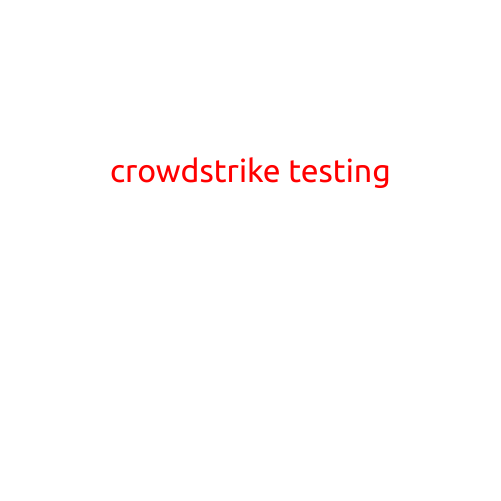
CrowdStrike Testing: A Comprehensive Guide to Evaluating the Security of Your Organization
As a security-conscious organization, it’s essential to ensure that your systems and data are protected from cyber threats. CrowdStrike is a leading cyber security solutions provider that offers a range of tools and services to help organizations detect, prevent, and respond to advanced threats. However, before implementing CrowdStrike, it’s crucial to conduct thorough testing to evaluate its effectiveness in your organization.
In this article, we’ll provide a comprehensive guide to CrowdStrike testing, including the types of testing you should perform, the benefits of testing, and best practices for a successful testing process.
Types of Testing
CrowdStrike testing can be categorized into three main types:
- Functional Testing: This type of testing evaluates the software and features of CrowdStrike to ensure they function as intended. This includes testing the user interface, configuration settings, and integration with other systems.
- Performance Testing: This type of testing assesses the speed, scalability, and reliability of CrowdStrike under various loads and scenarios. This includes testing the solution’s ability to handle large amounts of data and traffic.
- Threat Intelligence Testing: This type of testing evaluates the effectiveness of CrowdStrike’s threat intelligence capabilities in detecting and preventing real-world threats. This includes testing the solution’s ability to identify and block malicious activity.
Benefits of Testing
Conducting thorough testing of CrowdStrike provides several benefits, including:
- Compatibility and Integration Testing: Ensures that CrowdStrike integrates seamlessly with your existing systems and infrastructure.
- Error Identification and Resolution: Identifies and fixes errors, ensuring that the solution works as intended and minimizes downtime.
- Performance Optimization: Optimizes the performance of CrowdStrike, ensuring it can handle large amounts of data and traffic.
- Threat Detection and Prevention: Evaluates the effectiveness of CrowdStrike’s threat intelligence capabilities in detecting and preventing real-world threats.
- Compliance and Audit-readiness: Provides assurance that CrowdStrike is compliant with relevant regulations and standards.
Best Practices for a Successful Testing Process
To ensure a successful testing process, follow these best practices:
- Define Testing Objectives: Clearly define the testing objectives and scope to ensure a focused and effective testing process.
- Develop a Testing Plan: Create a comprehensive testing plan that outlines the testing approach, timeline, and resources required.
- Identify Test Cases: Develop relevant test cases that cover the key features and functionality of CrowdStrike.
- Conduct Testing in a Controlled Environment: Perform testing in a controlled environment, such as a sandbox or lab, to minimize risk and ensure consistency.
- Monitor and Log Test Results: Monitor and log test results to identify issues and track progress.
- Report and Document Test Findings: Document and report test findings, including defects, issues, and recommendations for improvement.
Conclusion
CrowdStrike testing is a crucial step in evaluating the security of your organization and ensuring that the solution is effective in detecting, preventing, and responding to advanced threats. By understanding the types of testing, benefits of testing, and best practices for a successful testing process, you can ensure a comprehensive and effective testing process. Remember to define testing objectives, develop a testing plan, identify test cases, and conduct testing in a controlled environment to minimize risk and ensure consistency.





